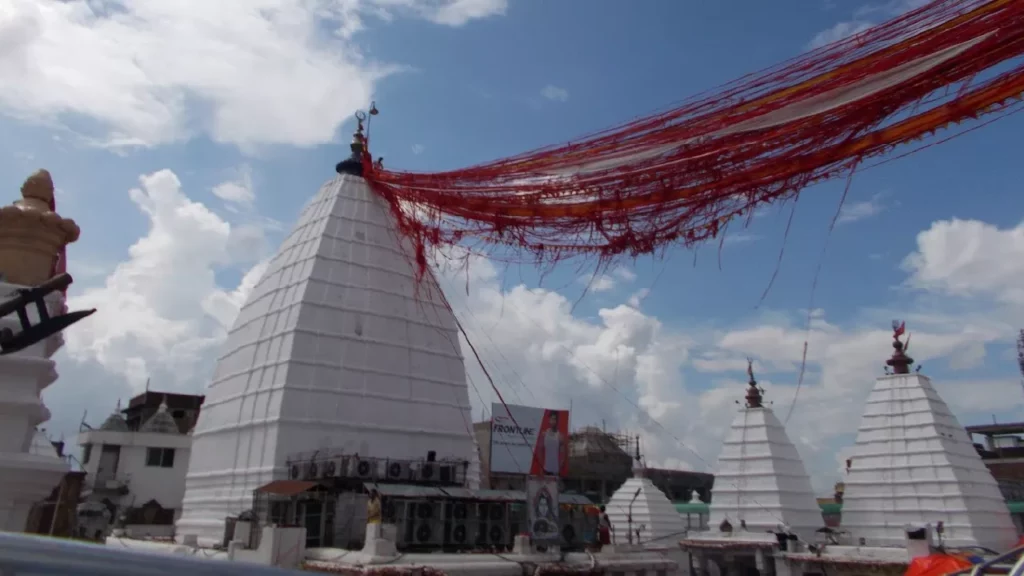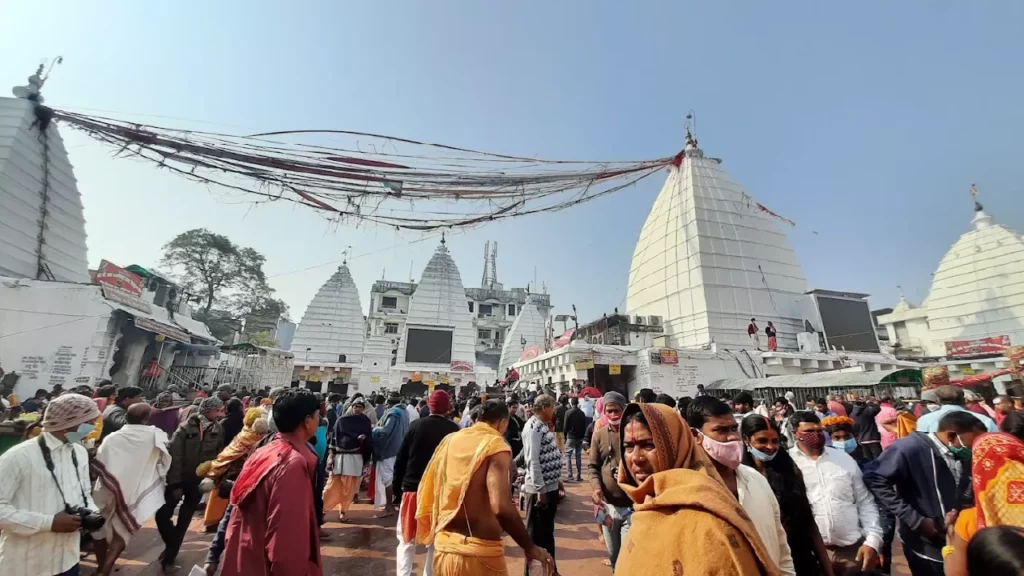Introduction
Overview of Baba Baidyanath Dham
Baba Baidyanath Dham, also known as Baidyanath Temple or Baidyanath Jyotirlinga, is one of the twelve Jyotirlinga shrines dedicated to Lord Shiva. The temple is located in Deoghar, Jharkhand, India and is considered one of the most sacred Hindu temples in India.
Significance of the temple
The temple is believed to have been built by the Hindu god Ravan and is one of the 51 Shakti Peethas, which are sacred shrines dedicated to the goddess Shakti. The temple is also believed to be one of the most powerful Jyotirlinga shrines, with the power to grant wishes and blessings to devotees.
Brief history of the temple
The temple has a rich history dating back to ancient times. It is believed to have been built by the Hindu god Ravan and has been mentioned in various Hindu texts such as the Ramayana and the Skanda Purana. The temple has undergone several renovations and additions over the centuries, and continues to be a major pilgrimage site for Hindus today.
The temple and its architecture
Description of the temple structure
The temple is a grand structure made of sandstone and granite. It has a pyramidal structure with a height of around 20 feet, with a shikhara (spire) on top. The temple complex also includes several smaller shrines, mandapas (halls) and a large tank (pond) known as Surya Kund.
Unique features of the temple
One of the unique features of the temple is the presence of a Nandi bull statue made of brass, which is placed at the entrance of the temple. The temple also houses a Shivlingam that is said to be one of the most powerful Jyotirlingas in India. The temple also has a dharamshala (guesthouse) for the convenience of the devotees.
Significance of the temple architecture
The temple architecture reflects the traditional Indian temple architecture, with intricate carvings and sculptures depicting various Hindu gods and goddesses. The temple is built in such a way that it aligns with the cardinal directions and the sun’s movement, which is said to enhance the spiritual energy of the temple. The temple is also said to have been built on an auspicious spot, which adds to its spiritual significance.
The deity and its worship
Description of the deity
The main deity of the temple is Lord Shiva, who is worshipped in the form of a Jyotirlinga. The Jyotirlinga is a representation of Lord Shiva in the form of a cosmic light and is considered one of the most powerful forms of Lord Shiva. The temple also houses several other deities including Lord Ganesha, Lord Parvati, and Lord Kartikeya.
Significance of the deity
Lord Shiva is one of the principal deities in Hinduism and is believed to be the destroyer of evil and the transformer of the universe. The Jyotirlinga form of Lord Shiva is believed to be the most powerful form of Lord Shiva and is said to grant blessings and wishes to those who worship it.
Worship rituals and customs
Devotees visiting the temple offer prayers and perform various rituals such as Abhishek (bathing of the deity with milk and other holy liquids), Haldi-Kumkum, and Aarti (waving of lighted wicks in front of the deity). Pilgrims also take a dip in the Surya Kund, which is believed to purify their minds and body before visiting the temple. The temple also has a tradition of offering Bilva leaves to Lord Shiva, which is considered highly auspicious.
Festivals and events
Overview of the main festivals celebrated at the temple
Some of the main festivals celebrated at the temple include Mahashivaratri, Shravan Mela, and Makar Sankranti. Mahashivaratri is a festival dedicated to Lord Shiva and is celebrated with great fervor at the temple. Shravan Mela is a month-long festival celebrated during the Hindu month of Shravan, and is considered one of the most important festivals at the temple. Makar Sankranti is a festival celebrated to mark the transition of the sun into the Makar rashi (Capricorn), and is also an important festival celebrated at the temple.
Description of the rituals and ceremonies associated with the festivals
The festivals are celebrated with great devotion and enthusiasm. On Mahashivaratri, devotees offer prayers, perform Abhishek and Haldi-Kumkum rituals, and stay awake throughout the night to perform aarti and sing devotional songs. During Shravan Mela, a large number of devotees come to the temple to offer prayers and take a dip in the Surya Kund.
The temple also provides accommodation and food for the devotees during the month-long festival. Makar Sankranti is celebrated by taking a dip in the Surya Kund, and offering prayers to Lord Shiva and the Sun God.
Significance of the festivals
The festivals celebrated at the temple hold great significance for the devotees. Mahashivaratri is considered the most important festival dedicated to Lord Shiva, and is believed to be the day when Lord Shiva was married to Parvati.
Shravan Mela is considered an important festival as it is believed that Lord Shiva himself appears in the temple during this month. Makar Sankranti is celebrated as it is believed that taking a dip in the Surya Kund on this day will wash away one’s sins and bring good luck.
Other places of interest
Description of nearby places of interest
Some of the nearby places of interest include the Sarnath Temple, Rameshwar Temple, and the Deoghar Museum. The Sarnath Temple is a temple dedicated to Lord Buddha, and is said to be the place where he delivered his first sermon.
The Rameshwar Temple is a temple dedicated to Lord Rama, and is said to be the place where Lord Rama worshipped Lord Shiva. The Deoghar Museum is a museum that showcases the rich cultural heritage and history of the region.
Significance of the places
The Sarnath Temple is considered an important Buddhist pilgrimage site, as it is believed to be the place where Lord Buddha delivered his first sermon. The Rameshwar Temple is considered an important Hindu pilgrimage site, as it is believed to be the place where Lord Rama worshipped Lord Shiva. The Deoghar Museum provides an insight into the rich cultural heritage and history of the region.
How to reach the places
The Sarnath Temple, Rameshwar Temple and the Deoghar Museum are located within Deoghar city, and can be easily reached by local transport such as buses, auto-rickshaws or taxi. The nearest railway station is Deoghar Railway Station and the nearest airport is Varanasi Airport, which is well connected to major cities in India.
Conclusion
Summary of the key takeaways
Baba Baidyanath Dham is one of the most sacred Hindu temples in India, dedicated to Lord Shiva in the form of a Jyotirlinga. The temple is known for its rich history, intricate architecture, and powerful spiritual energy. The temple attracts a large number of devotees throughout the year, especially during the festivals of Mahashivaratri, Shravan Mela, and Makar Sankranti. The temple is surrounded by other places of interest, including the Sarnath Temple, Rameshwar Temple, and the Deoghar Museum.
Significance of visiting the temple
Visiting the temple is considered an important pilgrimage for Hindus, as it is believed that the temple has the power to grant wishes and blessings to devotees. The temple is also considered an important architectural and cultural heritage site.
Tips for visiting the temple
It’s advisable to visit the temple during non-festive days as it can get quite crowded during festivals. It’s best to carry a photocopy of ID proof as it is mandatory to show it at the entrance. The temple is open from 4:00 am to 9:00 pm, it’s best to avoid visiting in the afternoon due to the heat. It’s also recommended to dress modestly and remove shoes before entering the temple.












